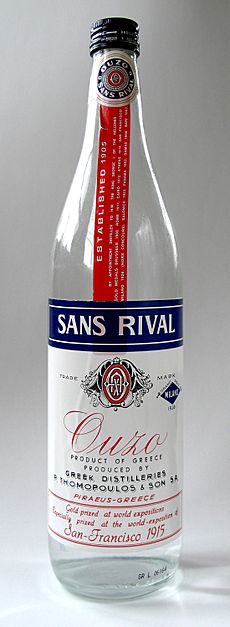Ouzo facts for kids
Ouzo is a famous Greek drink that tastes like licorice. It's often enjoyed before a meal. Ouzo is made from a type of strong alcohol that has been cleaned and flavored. Its taste is similar to other drinks like pastis, sambuca, and rakı, which also have an anise flavor.
Contents
History of Ouzo
Ouzo's story began with a drink called tsipouro. People say that monks on Mount Athos first made tsipouro in the 14th century. One version of this drink was flavored with anise, and over time, it became known as ouzo.
Modern ouzo making really started in the early 1800s, after Greece became independent. The very first ouzo factory opened in Tyrnavos in 1856. This is where the well-known ouzo Tyrnavou was created.
In the early 1900s, a drink called absinthe became less popular. Ouzo then became more famous, filling its place. People even called ouzo "a substitute for absinthe" because of their similar taste. By 1932, ouzo makers found a new way to make it using special copper pots called stills. This method is still used today.
Some of the biggest ouzo makers are Varvayanis and Pitsiladi. They are both located in the town of Plomari on the island of Lesbos.
On October 25, 2006, Greece won a special right. The European Union decided that ouzo can only be called ouzo if it comes from Greece or Cyprus. This is called a "Protected Designation of Origin." It means the name is protected, like how only champagne from a certain region in France can be called "Champagne."
You can even visit an ouzo museum in Plomari, on the island of Lesbos.
What Does "Ouzo" Mean?
The exact meaning of the name "ouzo" is a bit of a mystery. One popular idea comes from the Italian phrase "uso Marsiglia," which means "for use in Marseille." In the 1800s, this phrase was stamped on boxes of high-quality silkworm cocoons sent from Tyrnavos to Marseille.
There's a story that goes like this: In 1896, a doctor named Anastas Bey visited Tyrnavos. He tried the local tsipouro drink. He was so impressed by its quality that he said, "This is uso Marsiglia, my friends!" He meant it was top quality. People then started using the term "ouzo" to describe this excellent drink.
However, many Greek dictionaries say the name comes from the Turkish word üzüm, which means 'grape'.
How Ouzo is Made

Making ouzo starts with a strong, pure alcohol. Then, anise is added. Anise is a plant that gives ouzo its special licorice flavor. Sometimes, other spices are also added. These can include star anise, fennel, mastic (a plant resin), cardamom, coriander, cloves, and cinnamon. Each company has its own secret mix of these flavors.
This flavored alcohol is then put into copper stills and heated. This process is called distillation. It helps to clean and concentrate the flavors. After several hours, a very flavorful liquid is produced. This liquid is then mixed with water to reach the right strength. Sometimes, sugar is also added, especially for ouzo made in Southern Greece.
It's important to know that ouzo production does not involve fermentation. Fermentation is the process that makes alcohol in drinks like beer or wine.
How People Enjoy Ouzo
In Greece, there are special places called ouzeries. These are like cafes where people go to drink ouzo. Ouzo is usually mixed with water or ice. When you add water, the clear ouzo turns a milky-white color. This is a normal and fun part of drinking ouzo!
Ouzo is traditionally sipped slowly. It's often enjoyed with small plates of appetizers called mezedes. These can include small fresh fish, fries, olives, and feta cheese. People share mezedes with friends and family, often in the early evening.
In other countries, ouzo is sometimes served as a chilled shot before a meal in Greek restaurants. It's served very cold, sometimes with tiny ice crystals forming in the glass.
Ouzo in Cocktails
Ouzo is not usually found in many popular cocktail recipes. However, in Cyprus, there is a cocktail called an Ouzini that uses ouzo as its main ingredient.
Why Ouzo Changes Color
Ouzo is a clear liquid. But when you add water or ice, it magically turns a milky-white color. This happens because of a special ingredient called anethole. Anethole is the natural oil from anise. It dissolves perfectly in strong alcohol. However, it doesn't dissolve well in water.
So, when you add water to ouzo, the anethole separates from the alcohol. It forms tiny, tiny droplets that float in the liquid. These tiny droplets scatter the light, making the drink look cloudy and white. This cool effect is called "louching." You can also see this happen with other anise-flavored drinks like absinthe.
Drinks with Similar Flavors
Many countries have drinks that taste similar to ouzo because they also use anise. Some of these include:
- Sambuca from Italy
- Pastis from France
- Rakı from Turkey
- Arak from the Middle East
- Anís from Spain
- Absinthe from France and Switzerland
In Bulgaria and North Macedonia, there's a similar drink called mastika. This drink is often served over ice with meze, just like ouzo. It has a warm taste and is usually made from grapes.
See also
 In Spanish: Ouzo para niños
In Spanish: Ouzo para niños


